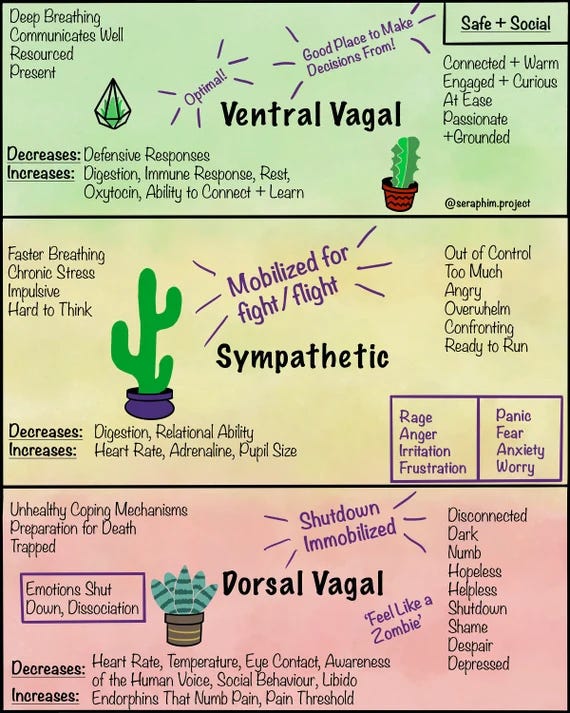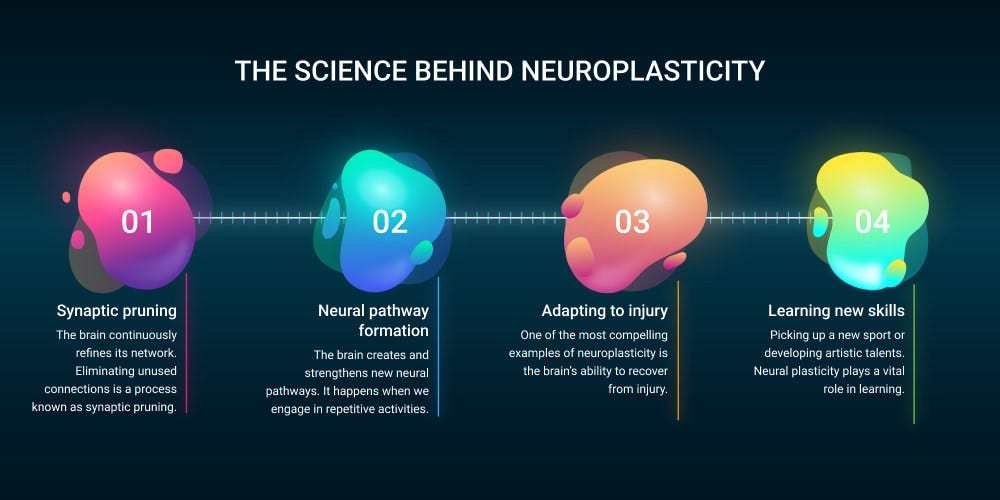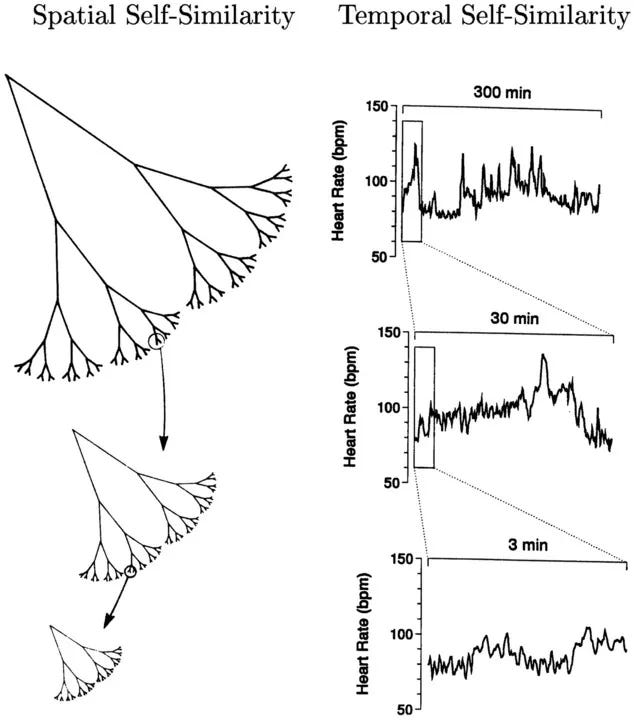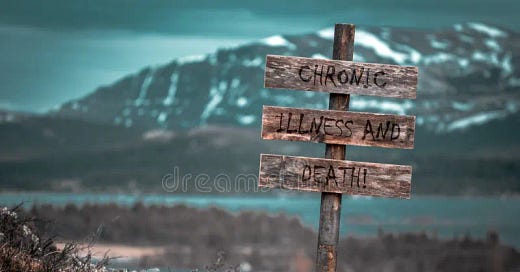The Cellular Biology of Authoritarianism and Collapse- "When Protection Becomes Prison"
How the Question "Am I Okay?" Shapes Cells, Individuals, and Society
This essay examines how a single question—"Am I okay?”—shapes outcomes across scales from cellular biology to societal structures. It identifies a pattern where defensive responses, initially protective, become self-perpetuating systems of constraint whether in mitochondria, nervous systems, or society. Drawing connections between how perceived threats trigger similar protective mechanisms in chronic illness, trauma responses, and authoritarian tendencies across systems. The biological-social feedback loop creates conditions where individual health crises reflect collective dysfunction. By recognizing moments of safety within perceived danger and practicing conscious reconnection, transformation becomes possible not through forcing change but through relationships that integrate both protection and growth.
When Protection Becomes Prison
Your cells and our society are answering the same question incorrectly, and it's making us all sick. Every moment, from your mitochondria to global markets, politics, a single question determines whether we heal or deteriorate: “Am I okay?”
The answer shapes everything from cellular health to the fate of human society, and our planet.
I first discovered this pattern in my own body when I transformed from seemingly healthy into a collection of fear-based patterns, innumerable symptoms, and unsatisfactory diagnoses during years of chronic illness. Chronic fatigue sidelined me and things I normally enjoyed became threats. Life developed into a game of avoiding danger.
Mold toxicity, under the radar, weakened my system over many years, then the shock trauma of an acute exposure, and contracting COVID simultaneously pushed my cells into full defense mode. This layering— one threat compounding another— creates the conditions for chronic illness. It's rarely just one thing.
When cells encounter threats— whether mold spores or trauma embedded in fascia— they don't deliberate. Membranes harden. Vigilance intensifies. Communication with neighboring cells diminishes. Mitochondria shift from producing energy for growth to prioritizing defense. They isolate to protect against perceived danger.
This response is brilliant biology when facing actual danger. The problem emerges when protection persists after the threat passes. Dr. Robert Naviaux named this the “cell danger response” in his 2014 research on mitochondrial function, he showed how cells lock in a defensive state, causing metabolic changes that emerge as chronic illness. I call this the moment when protection becomes prison. It's when the body becomes authoritarian.
What's striking is how this pattern tracks at scale.

The Societal Cell Danger Response
After collective shock traumas like 9/11, our societal systems mirrored this cellular response. Security measures expanded; boundaries hardened; surveillance intensified through new institutional structures like the Department of Homeland Security. The resulting wars, justified by claims later disproven, extended this defensive posture globally— identical to how a traumatized cell might respond to a non-existent threat after trauma.
Nearly a quarter-century later, COVID-19 deepened this contraction further. Nations restricted borders and citizens. Schools closed, remote work became mandatory, economic activity slowed. The outside world itself became the danger. And if we weren't already, society became chronically ill. Authoritarianism became evident because that’s what systems do; biology to society.
We all know we've built economies around this prolonged protective state. Defense contractors profit from perpetual threat perception. Pharmaceutical companies benefit from chronic biological vigilance. Capitalistic systems profiting from fear have little incentive to help us heal. Instead, they perpetuate alarm states that develop into protective patterns in our cells, increasing vulnerability to all threats.
Cameras guarding every doorway, media feeding constant fear, societies building higher walls, you looking at your phone in a conscious decision not to interact with others in public. This isn't random— economies thrive on our perpetual vigilance and captured attention.
When protection becomes prison, society becomes chronically ill.
The Biological-Social Interface
The Cell Danger Response appears collectively through chronic stress responses from media exacerbating division and foreign threat, financial instability amidst inflation, and intensifying work and family demands that activate inflammatory pathways to name a few. Not all, but many chronic illness sufferers are high achievers prone to burnout— a classic side-effect of relentless capitalism.
Environmental toxins, poor nutrition, and technological overstimulation trigger cellular defense mechanisms and mitochondrial dysfunction and persistent low-grade threat responses and attention fragmentation. This creates an undercurrent of pervasive illness, evidenced by the high percentage of COVID-19 deaths associated with pre-existing conditions. 64.8-94% in studies. It's rarely one isolated factor leading to chronic illness, it’s layered.
Chronic illness often manifests in bodies carrying unresolved complex trauma. Through the NARM (NeuroAffective Relational Model) lens, our disconnection from authentic needs and reliance on adaptive survival styles— whether through achievement, people-pleasing, or perfectionism to name a few— creates the physiological conditions for cellular defense to become chronic. These patterns, present in nearly everyone to some degree, set the stage for illness when additional stressors overwhelm the system's compensatory mechanisms.
These biological adaptations create population-wide conditions facilitating authoritarian shifts through trauma-based decision-making that prioritizes security over freedom, narrowed thinking that reduces complex problem-solving, and social disconnection through stress-induced self-protection. Resource-defensive postures amplify scarcity mindsets and outgroup hostility, while heightened fear responses become exploitable by authoritarian messaging. We've been making this slow march for 25 years, maybe longer. Authoritarianism is just how this pattern plays out.
A biological-social feedback loop is created here: systemic stressors trigger collective defensive postures that make populations more vulnerable to the very control mechanisms perpetuating the original stressors— a perfect trap of protection becoming prison at societal scale.
This feedback loop becomes intergenerational. Unprocessed collective trauma creates cultural blind spots that perpetuate reactive cycles, with each generation inheriting not just the trauma but the unconscious coping mechanisms of their predecessors.
The Neural Architecture of Fear
Inside your body, cellular isolation triggers a biochemical cascade that mirrors our societal responses. Your limbic system signals danger, flooding you with cortisol, adrenaline, and norepinephrine instead of the healing quartet of dopamine, oxytocin, serotonin, and endorphins. With each unconscious “No” to the question “Am I okay?”, your body contracts further and your defense budget increases.
Stephen Porges' Polyvagal Theory elegantly maps how our autonomic nervous system evolved three distinct neural circuits: the ventral vagal pathway supporting social connection, the sympathetic activating fight/flight, and the dorsal vagal triggering freeze/shutdown. When threats are detected, we move from connection to mobilization to immobilization—from engagement to defense to collapse. This pattern plays out at the scale of biology to society.
Threat detection happens through “neuroception”— a process below conscious awareness where our nervous system constantly scans for signals of safety or danger. This neuroception evaluates risk without consulting our rational mind, which is why logical reassurance rarely calms a trauma-activated nervous system. The body has its own wisdom, and safety is an inside job.
The tragedy deepens with time. In chronic illness, your brain—that wondrous adaptation mechanism—begins to betray you, sprouting new receptors for stress. Neural pathways physically carve themselves into deep canyons of fear until anxiety and or collapse becomes your inner culture. Synaptic connections multiply along these fear circuits while connections supporting trust atrophy from disuse.

Encoded Survival Patterns
There are 2 distinct patterns in nervous system adaptations to threat. With shock trauma, the nervous system responds with immediate survival reactions. Left unprocessed, the body stores incomplete defensive responses, creating patterns where similar triggers reactivate the original survival physiology years later— like cellular memory of a pathogen long departed. This brainstem process is what leads to PTSD.
When early relationships are chronically disrupted constant adaptation creates strain and rewires your brain to process relationships as survival threats. You begin to identify through shame-based identifications rather than authenticity. As Lawrence Heller explains: “When there is early disruption in attachment and regulation, our relationship with ourselves, with others, and with the world becomes organized around survival rather than around connection, meaning, and joy.”
These patterns, while initially helpful, become automatic responses that persist into adulthood even when the original dangers are gone— similar to how cells remain in defense mode after threats recede, so does your psyche.
For chronic illness sufferers, this biological betrayal feels both maddening and paralyzing. Our brains are wiring for exactly what we don't want. Cells unwittingly manifest physically the very conditions you're desperately trying to heal.
Capitalism as Societal Complex Trauma
Perhaps the most compelling aspect of this pattern is how capitalism itself functions as a form of societal complex trauma. Like how individuals develop adaptive survival styles in response to developmental trauma, our economic system represents a collective adaptation to historical scarcity and threats.
In capitalism, this manifests as “Moloch”— the emergent force compelling market participants to pursue profit at the expense of human values. Competitive pressures force us to make collectively harmful decisions that no individual desires, but all seemingly must participate in to survive.
Society becomes “egosyntonic”— meaning we've integrated these patterns so completely that they feel like an inherent part of who we are rather than an adaptation— believing this is just how it is, not realizing we're acting out a trauma response we've mistaken for our economic personality.
Alternatives like bioregional regenerative living seems alien due to the length of time we’ve spent playing out this adaptive response. Across scale we believe, “this is just who I am, this is just how it is.” As an alternative to capitalism, bioregional regenerative living emerges through practices like local food systems that reduce transportation emissions while building community resilience, watershed-based governance that honors natural boundaries rather than arbitrary political ones, and place-based economies where currencies circulate within ecological limits while strengthening relationships between producers and consumers in ways that mirror healthy cellular communication.
Just as trauma survivors develop adaptive styles that once protected them but later cause disconnection from self and others, capitalism institutionalizes self-protective mechanisms that eventually create their own forms of suffering. The emphasis on individualism, competition, and consumption mirrors the disconnection from authentic needs seen in trauma responses. External validation and resource acquisition become substitutes for genuine connection and internalized security.
This economic system persists despite creating widespread psychological distress because it originated as an adaptive response. The market's invisible hand becomes the traumatized nervous system of society— constantly scanning for threats, prioritizing short-term survival over long-term wellbeing, and struggling to trust in abundance rather than scarcity.
Recognition
Healing begins not with solutions but with a fundamental shift in perception. It starts with recognizing that our relationship to the question “Am I okay?” shapes everything that follows. This question relates to the physical body and emotional self, interpersonally and societally. And, as we will see, it’s ultimately a spiritual question in nature.
This recognition isn't intellectual— it must penetrate to the cellular level, through to the limbic system, to the places beyond conscious control. It arrives as a felt sense rather than a thought. Having cognitive understanding is a move toward embodiment. Unfortunately, you'll likely have to taste it. This fractal perspective highlights the fact we are all eating this meal of chronic illness.
My training taught me about these processes years ago, but I learned it on an embodied level just recently while sitting in the sun on a cahone watching birds in the desert. For just a moment, I could feel myself answering the question differently: “Yes, I am okay right now, in this precise moment.” Not forever, not completely— just here, just now. That tiny quantum of safety allowed something to soften and it's expanding gently. It's a practice I can repeat, not as an affirmation, but as a noticing of what's actually true— in this present moment. I smile at my cells and as silly as it might sound, I feel them smiling back.
This practice resembles what collective trauma teacher Thomas Hübl calls “time competency”— the ability to fully inhabit the present moment despite trauma's tendency to collapse time. When we're trauma-activated, Hübl explains, we lose our capacity to distinguish between past danger and present safety. We become “time-incompetent,” with our nervous systems responding to memories as though the threat were still occurring. Developing time competency means reclaiming the present moment from trauma's temporal distortion— recognizing that while the memory exists now, the event itself does not.
You might reasonably ask: isn't this just another version of “think positive” that ignores real threats? The difference is crucial. I'm not suggesting we deny genuine danger or pretend everything is fine when it isn't. Rather, I'm pointing to the possibility of recognizing moments of actual safety amid perceived danger— of distinguishing between past threats stored in the body and present-moment reality. Try it now, how many ways can you name your “okayness?”
Energy can begin to shift from defense to creation. Authentic purpose eventually returns. The mitochondria remember their primary function isn't protection but generation. The cell wall becomes permeable again— not recklessly, but selectively. We can, as neuroscientist Rick Hanson reminds us, “Taking in the good is the deliberate internalization of positive experiences in implicit memory. It involves enriching the experience, absorbing it, and linking positive and negative material so that positive aspects of your psyche increasingly help to heal, counter, and eventually replace negative ones.”
In my healing journey, this was making art again. Immersing myself in nature. Writing these words. Finding purpose beyond survival. Getting lost enough in the pattern to be found. Storyteller Martin Shaw once said, and I’ll paraphrase, “..in the Exodus and other stories of getting lost, the protagonist enters an actual or proverbial desert with a question and if they’re lucky they wander long enough not for an answer, but for the question itself to change.”
A Personal Practice of Reconnection
This understanding transformed into daily practice. When my body signals danger, I:
Take conscious breaths to interrupt reactivity
Identify physical sensations and remove myself from triggers when possible
Orient to safety by noticing surroundings and body boundaries
Remind my cells: "My inflammatory response is happening, AND I am safe enough to breathe right now"
Place a hand on my heart and smile, triggering healing neurochemicals
Smiling activates a neurobiological flow of dopamine, endorphins, and serotonin while inhibiting cortisol. Even forced smiles can initiate this process, creating a positive feedback loop that strengthens both emotional regulation and social connection.
This practice creates resource states—brief experiences of safety that build new neural pathways. With consistent practice, I've observed measurable changes in inflammation response, symptom dominos, and resilience to triggers.
This personal practice scales to social systems. Just as individuals can interrupt their defensive patterns through conscious breathing and orienting to safety, communities can create “coherence spaces” where collective threat responses are acknowledged without amplification. Town halls and neighborhood assembly’s focused on connection rather than division, community rituals that honor shared values despite differences, and economic models that prioritize regeneration over extraction all represent societal versions of the same healing pattern.
The Central Paradox
Cells and societies heal through the same paradox: we need safety to heal, yet cannot feel safe until healing begins.
Cells can’t detoxify while in protection mode, yet must release some protection to begin detoxification. Trauma survivors cannot heal without safety, yet must take risks that feel unsafe to create that safety. Our society cannot address existential challenges while in perpetual alarm, yet these challenges themselves trigger our collective alarm systems.
The resolution lies in the willingness to expand slightly beyond our comfort zone, to answer “Am I okay?” with a paradoxical “yes, even though...” It's finding that space of safety within a rapidly changing climate, that possibility of connection amid disconnection.

Remembering Connection
If the protective response at every scale essentially says, “I must disconnect to survive,” remembering the whispers “I must reconnect to thrive” are essential in the darkest of times. In these shifting moments, a pattern interrupt can help us to look deeper into our experience and notice some bit of safety within the chaos. This pattern interrupt is noticing at the very least, “I'm not dead right now” and if true, “in this immediate moment, my life is safe enough to breathe this next breath.” Societal pattern interrupts might look like major shifts in governance.
In Dr. Naviaux's model, this is when cells that remember health begin teaching those that have only known stress. The cellular community reestablishes these crucial conversations. The elder cells literally offer intergenerational transmission. The mother tree begins distributing nutrients to the forest again after the fire. Neighbors invite neighbors and their families for dinner. Elders remind everyone, the way forward is one of love, not fear.
This reconnection process is far more than a psychological preference—it's a biological imperative. Social connection is not a luxury but a neurobiological necessity, as vital to our survival as air or water. Through co-regulation, our nervous systems actually help regulate each other, creating neural feedback loops that can either amplify fear or signal safety. This co-regulation happens primarily through the Social Engagement System—involving facial expressions, eye contact, vocal tone, and body language that signal safety between mammals.
Consider the implications of widespread mask-wearing during the pandemic: While many believed it necessary for public health protection, infants born during this period encountered primarily masked faces outside their immediate family. This created a unique developmental situation where babies' neuroception systems— which rely heavily on facial cues— received altered inputs during critical periods. While controversial and potentially helpful for viral protection, this intervention may have unintentionally disrupted the very co-regulatory mechanisms through which developing nervous systems learn to recognize safety in others. Research is still emerging on potential impacts, but this tension exemplifies how protective measures at one scale can create adaptive challenges at another. These children may benefit from additional opportunities for facial co-regulation and safety signaling.
For me, healing and finding safety meant understanding the cell danger response and finding others who had walked similar paths—not to commiserate about illness but to be inspired by their wins and share my own. To remind each other what health feels like and to reinforce the truth of this systemic pattern. It is the connection that helps me remember. Most importantly, my connection with nature. Sleeping under the winter stars with the coyotes. To practice connection even when everything urges contraction is one of faith. Faith doesn't have to be religious faith, although it can be, but a belief in, and a deep trust in life itself.
This movement toward reconnection is a practice where we remain present to both our internal sensations and our relational field simultaneously. In his collective trauma integration process, Hübl demonstrates how healing accelerates exponentially when groups create what he terms “coherence fields”— shared attentional spaces where trauma patterns that were previously invisible become coherent and accessible for integration. Like cells reestablishing intercellular communication, humans in coherence fields can metabolize trauma energy that was too overwhelming to process alone.
Integration
Healing is not a destination but a continuous unfolding. It embraces the both/and of analytical understanding and embodied wisdom. The right and the left hemisphere of the brain. It’s best integrated top down and bottom up.
At the cellular level, this means both targeted interventions and whole-system support. Both cognitive understanding and somatic experiencing. At the societal level, it means both practical local governing for regeneration and paradigm shifts in how we relate to each other and the planet. It means taking agency and making choices with our dollars as well as our attention that are regenerative choices that heal us from our current economic systems vast trauma.
There are no simple solutions. Instead, something more profound: the capacity to stay present with complexity without becoming overwhelmed by it. To ask, in each moment, “What is the next right step?” rather than demanding a comprehensive roadmap.
Our longing for solutions betrays us here. We search for answers in institutions: five-step plans to heal chronic illness, straightforward policies to restore ecological balance, clear pathways through societal disruption. But complex systems don't yield to linear thinking. They can't. Every action has ripples whose causality cannot be fully comprehended because it’s all interconnected and ultimately a mystery.
Systems theorist, Nora Bateson reminds us, “The temptation is to try to find solutions, but I think we need to learn to dwell in the realm of multiple contexts simultaneously, to study the relationships between them. This is not about answers; it is about vitality and calibration to complexity.”
Instead of searching for one-size-fits-all solutions, complex living systems need us to see things from multiple angles simultaneously. This is what Bateson calls “transcontextual thinking” - the ability to look across different contexts and understand how they connect and influence each other. Rather than seeking direct A-to-B paths forward, we need to develop the skill of seeing patterns and relationships between seemingly separate areas of a system.
This challenge is the integration of spiritual awareness with trauma healing. True integration happens not through solving complexity but through expanding our capacity to hold it. We must develop inner spaciousness that allows us to witness both our trauma responses and our healing impulses simultaneously without becoming identified with either. This spaciousness resembles the cellular intelligence that knows when to harden for protection and when to soften for connection.
The cell danger response isn't solved through force or will— it transforms through relationship. It transforms through our cells' relationships with each other, our simple relationships with our neighbors, and our relationship to Earth. It's fractal that way.
Integration understands that our initial question—"Am I okay?”— never receives a final answer. Instead, it becomes a practice, a way of being with uncertainty that neither collapses into despair nor escapes into false certainty.

The Pattern That Reconnects
What makes this journey reflective is its symmetry across scales. The same fundamental dynamics shape healing in autoimmune disease and society at large.
When we witness suffering without becoming overwhelmed— whether our own or others'— we help metabolize what was previously frozen. We develop a competent witnessing of trauma. Collective presencing creates a larger nervous system that can hold what individual systems cannot. We can’t do it alone, and no one can do it for us.
I've seen this pattern playing out in my cellular healing, in communities recovering from collective trauma, in forests regenerating after fire, and in political systems straining toward renewal.
The question reverberates across scale. We must acknowledge the trauma, recognize our adaptations, see that paradoxically we’re “ok”, at the very least, “not dead” and “profoundly not ok” simultaneously— then take that first courageous breath toward connection.
The answer to “Am I okay?” determines everything— not because it's fixed, but because it shapes what happens next at a cellular level. It determines whether we build or defend, connect or contract, expand or retreat, heal or remain ill.
Your cells and society are waiting for your answer.
~
Your grief for what you've lost lifts a mirror
up to where you're bravely working.
Expecting the worst, you look, and instead,
here's the joyful face you've been wanting to see.
Your hand opens and closes and opens and closes.
If it were always a fist or always stretched open,
you would be paralyzed.
Your deepest presence is
in every small contracting and expanding,
the two as beautifully balanced and coordinated
as bird wings.
-Rumi
If you enjoyed this essay, consider becoming a paid subscriber. For the price of a bag of avocado’s a month, you could support my work in a big way!
With Love,
Patrick


